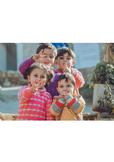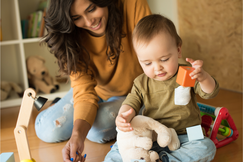Mom, dad, kid - not necessarily
How can parents promote the appreciation of diversity in the classroom?
Parents or rather guardians are not equal to mum and dad. At the parent-teacher conference, teachers may also face the following people:

What does family mean in essence?
The emotional home and the people who shape it: That's family. How different a family can be is not taken up enough in the classroom, also because many commercials, posters, unfortunately also some school books and our thinking is shaped by the long outdated image of mum, dad and child. The reality in 2020 paints a much more colourful picture of what family can look like. (Reality in the year 2020).
Anton and Esther: Two children, two special families
Imagine these two kids in a classroom. They show what family can look like.
Anton grows up with two mothers, his biological father is a friend of the family, who also takes the boy on outings now and then or takes him to his home for the weekend.
Esther's daddy is not her biological father. Her mother was pregnant by another man when she met her dad. Both raised the girl together. After the separation the girl stays with the adoptive father who has Custody of her.
Conclusion: Each family is special and unique and at the same time normal. Just because children grow up differently, as the examples illustrate, different life worlds must be taken up by the teacher in the classroom.
What should sensitive teaching look like?
Language shapes thinking and is therefore the most important means that teachers have to convey acceptance and tolerance. When teachers stick to dusty textbooks with white mommy-daddy families, children like Esther and Anton feel that they do not belong or even feel excluded.
Teachers have the following opportunities to express their appreciation:
- Always enumerate all possibilities of family
- Select texts so that different children can find themselves in the family stories and main characters.
- Create small texts yourself
Here you can find book recommendations on the topic of "diverse families" for children and young people of all ages, for reading by yourself or for teaching.
Conclusion: Sensitive teaching appreciates your child and its history. If you have the feeling that the teacher does not take your child sufficiently into account or does not convey an appreciative image of diversity, you can talk to the teacher about your impressions.
What can you do if your child is insulted or excluded at school?
In many federal states there is an hour called "social training" or "social learning" on the timetable. In the Berlin primary school it is part of the German lessons. Teachers should use this time for peace in the classroom. If disputes and insults are the order of the day, teachers have the possibility to call the Class Council. Children may then:
- Expressing all the conflicts and hurt feelings in the air
- Finding solutions on your own and reflecting on yourself
- Assume roles such as "control monitor" or "moderator
- Recording agreements in the protocol
Here you can find more information and materials on how to conduct a class council.
You can point out this method to the teacher, because one of her tasks is to teach content, but also to educate. If this measure is not sufficient, it is helpful:
- Seeking a conversation with the teacher
- Contact the parent representatives
- Addressing problems and conflicts at the parents' evening
- Or to arrange a meeting with the school management
Conclusion: Wherever there are large numbers of people, there are also difficulties, arguments or discrimination. The classroom is a good place to deal with conflicts in a safe environment. But only if the teacher declares appreciation and tolerance to be the norm.
Protecting and embracing diversity in the "small world" of the classroom
A classroom is also always a kind of "small world" in which social issues are depicted in a tiny frame. Children form a picture here of who they are allowed to be and how they are accepted.
Sensitive teachers have the task of protecting diversity here. They should convey that although life worlds differ, all family forms have their right to exist and are valuable. If teachers do not fulfil their role here sufficiently, you as a parent are called upon to seek dialogue
If you would like to learn about perspectives on how families deal with challenging situations or want to know more about how children learn well, you will find some suggestions in the magazine
Published on
Topics
Articles on the topic
-
How do I find a school place for my child?
Depending on the state and type of school, different things need to be...

-
Childcare - how does it work in Germany?
The path from application to daycare place is simple and complicated at...

-
You don't have to be a read-aloud king or queen, but..
Reading adventures with your child are not to be missed!

-
Corona - and then what?
How you can support your teenager with fear of the future

-
Good night, clichés!
"modern" books for children and young people

-
From infant to toddler
Short years full of milestones
